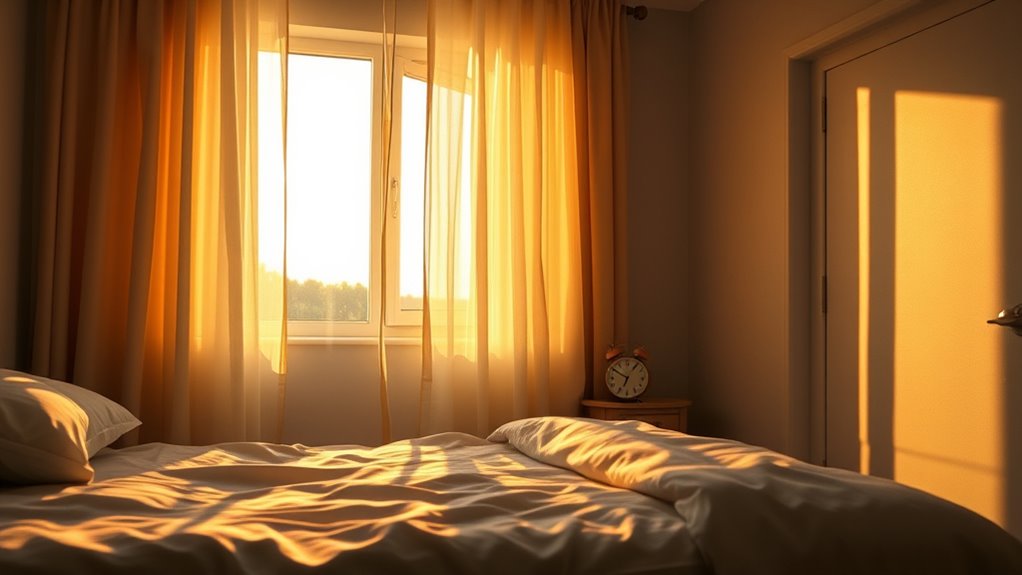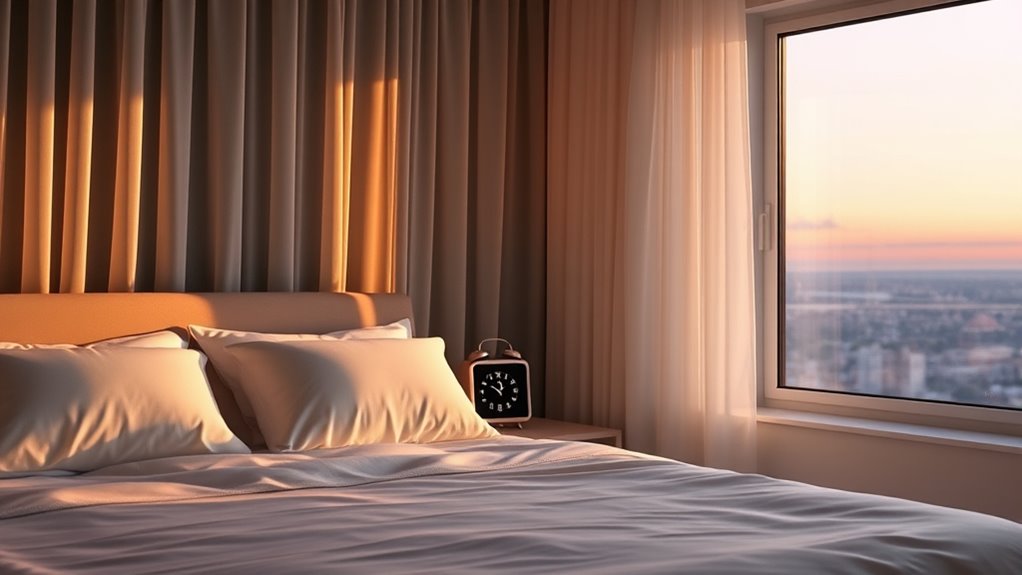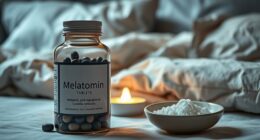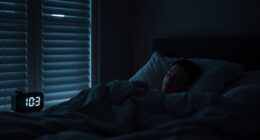Your body’s internal clock, called the circadian rhythm, controls your sleep-wake cycle over roughly 24 hours and is heavily influenced by light exposure. Bright light during the day suppresses melatonin, helping you stay alert, while darkness in the evening boosts melatonin to promote sleep. Disruptions can lead to poor sleep and fatigue. Understanding how light affects this cycle can help you improve your sleep habits, and discovering this connection will show you ways to better sync with your natural rhythm.
Key Takeaways
- The circadian rhythm is an internal 24-hour clock that regulates sleep-wake cycles and other body functions.
- Light exposure, especially natural daylight, synchronizes circadian rhythms by influencing melatonin production.
- Melatonin hormone levels rise in darkness to promote sleep and decrease with light exposure to signal wakefulness.
- Disrupted light patterns, such as screens before bed or irregular schedules, can impair circadian rhythm and sleep quality.
- Maintaining consistent routines with appropriate light exposure supports healthy circadian functioning and better sleep.

Your body operates on a natural internal clock called the circadian rhythm, which regulates your sleep-wake cycle over roughly 24 hours. This internal clock influences when you feel alert and when you feel sleepy, helping your body synchronize with the day-night cycle. One of the key ways your circadian rhythm maintains this balance is through light exposure. During the day, exposure to natural light signals to your brain that it’s time to be awake, suppressing the production of melatonin, the hormone responsible for sleepiness. As evening approaches and light levels diminish, your body increases melatonin production, making you feel sleepy and preparing you for rest.
Your circadian rhythm uses light exposure to regulate sleep and wakefulness naturally.
Light exposure plays a pivotal role in melatonin regulation. When your eyes detect light—especially blue light from screens or artificial sources—your brain receives signals to inhibit melatonin release. This delay in melatonin production can make it harder to fall asleep at your usual bedtime, leading to disruptions in your sleep cycle. Conversely, exposure to darkness prompts your brain to increase melatonin secretion, helping you feel sleepy at night. That’s why maintaining a consistent light-dark environment is essential; irregular light exposure can throw off your circadian rhythm, resulting in poor sleep quality or difficulty waking up refreshed.
Understanding how light influences melatonin regulation empowers you to optimize your sleep hygiene. For example, limiting screen time before bed reduces blue light exposure, allowing melatonin to rise naturally and making it easier to fall asleep. Conversely, getting plenty of natural light during the day helps reinforce your body’s internal clock, keeping your sleep-wake cycle aligned with the environment. If you work night shifts or have irregular schedules, using light therapy lamps or wearing blue light-blocking glasses can help mimic natural light cues, supporting your circadian rhythm.
Your sleep quality depends heavily on how well your internal clock responds to light cues. Disrupting this harmony—by staying indoors too long, using screens late into the night, or traveling across time zones—can impair melatonin regulation and throw off your entire sleep cycle. That’s why establishing consistent routines for light exposure and darkness is essential. Additionally, understanding the light-dark cycle and its effects on your circadian rhythm can help you make better decisions about sleep timing and environment. By doing so, you help your circadian rhythm maintain its natural rhythm, making it easier for your body to transition smoothly between wakefulness and sleep. Ultimately, understanding the relationship between light exposure and melatonin regulation allows you to make smarter choices that support healthy sleep patterns and overall well-being.
Frequently Asked Questions
How Do Shift Workers Manage Their Circadian Disruptions?
As a shift worker, you can manage circadian disruptions by using light therapy to reset your internal clock and improve alertness during night shifts. Additionally, strategic napping before or during breaks helps reduce fatigue and maintain focus. These methods help align your sleep-wake cycle with your work schedule, making it easier to stay alert and recover sleep quality despite irregular hours.
Can Circadian Rhythms Influence Mental Health Disorders?
Circadian rhythms can profoundly influence mental health disorders. You might find that genetic factors affect your biological clock, making you more prone to conditions like depression or anxiety. Hormonal influences, such as fluctuations in cortisol and melatonin, also play a role in mood regulation. When these rhythms are disrupted, it can lead to mental health issues, highlighting the importance of maintaining regular sleep-wake cycles for your emotional well-being.
Are Age-Related Changes in Circadian Rhythms Inevitable?
You might wonder if those age-related changes in your circadian rhythms are unavoidable. While biological aging and genetic factors influence these shifts, they’re not set in stone. You can still take steps to maintain healthy rhythms, like adjusting your sleep schedule and managing light exposure. Though some changes are natural, understanding your body’s signals helps you stay in sync longer, defying the idea that aging inevitably disrupts your internal clock.
How Does Light Pollution Affect Sleep Patterns?
Light pollution disrupts your sleep patterns by interfering with your body’s natural signals. When you’re exposed to artificial light, especially at night, it suppresses melatonin production, making it harder to fall asleep and stay asleep. This disruption can lead to poor sleep quality and health issues over time. To improve your sleep, limit exposure to light pollution in the evening by dimming lights and avoiding screens before bed.
Can Circadian Rhythm Disruptions Be Completely Reversed?
Circadian rhythm disruptions can often be reversed, but it depends on the cause. You can restore your natural cycle by improving sleep habits, reducing light exposure at night, and maintaining a consistent schedule. Genetic factors and hormonal regulation play roles in how easily your rhythm adjusts. While some disruptions are fully reversible, others may require ongoing management, especially if underlying biological factors are involved.
Conclusion
By understanding your circadian rhythms, you can optimize your sleep and boost your overall health. Imagine staying up late for a project, then feeling sluggish the next day because your body isn’t aligned with its natural cycle. If you listen to your body and stick to consistent sleep times, you’ll notice improved energy and mood. Paying attention to your internal clock helps you sleep better and live healthier every day.









